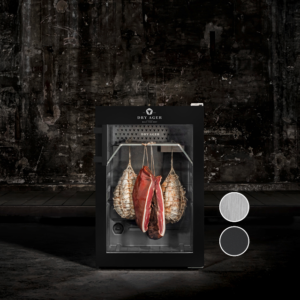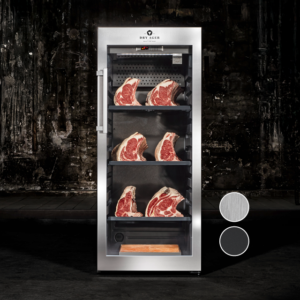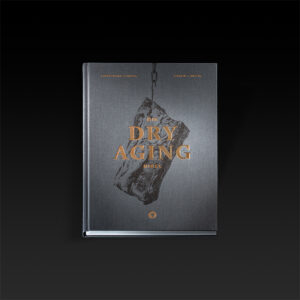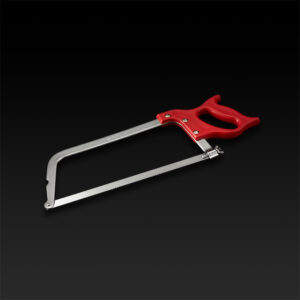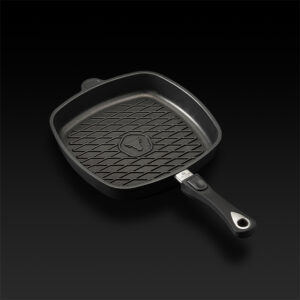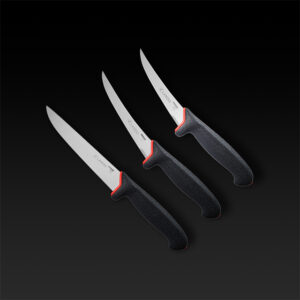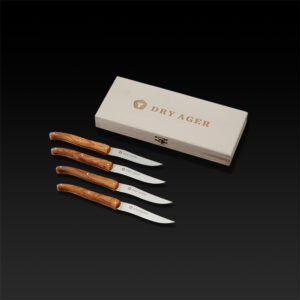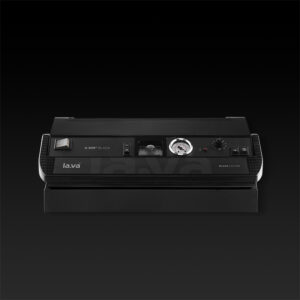How meat is properly processed – so the dry maturing succeeds

The dry-aging of beef is also called lapidary “hang”. The term deceives simplicity. Hanging alone is not the only way to do this with the suspension of the meat. The size of the piece of meat, the quality and even the breed of the animal of origin influence the maturing process. It’s the trickiest task. During dry-aging, pathogenic, ie pathogenic, bacteria can develop. This makes the meat not only inedible, but also dangerous. In order to counteract this, regulated humidity conditions and, as always with the processing of meat, the hygienical conditions in the dry aging process the A and O.
The first cut – buy or cut meat parts?
 Before the meat is aged, a final product should be fixed. Juicy steaks for the grill or finest fillet for the Christmas table? Depending on what is on the plate, the right piece of the animal must be selected. The different blanks are also called “cuts”. One way to get the right cut is the order at the butcher. This makes sense especially for dry ripening in special Dry Aging bags, since no large parts can be processed and only meat without bones, which leads to a considerably higher weight loss (up to 25% after 4 weeks). Dry Aging in DRY AGER® allows for more space and allows the bone to mature, resulting in significantly less loss of weight (10% at the end of 4 weeks) and the maturation of the bone brings with it. Two to about 100 kg in the large tire cabinet DX 1000 can unfold in full glory. This increases flexibility and variability. All classic steak cuts can be cut from a backstring (Rumpsteak, Êntrecote, etc.) but also bone-brittle like Porterhouse, T-Bone or Tomahawk. What is needed is a stable working surface and an adequate tool set. It consists of a bone saw, a small hatchet and a sharp meat knife or bonnet.
Before the meat is aged, a final product should be fixed. Juicy steaks for the grill or finest fillet for the Christmas table? Depending on what is on the plate, the right piece of the animal must be selected. The different blanks are also called “cuts”. One way to get the right cut is the order at the butcher. This makes sense especially for dry ripening in special Dry Aging bags, since no large parts can be processed and only meat without bones, which leads to a considerably higher weight loss (up to 25% after 4 weeks). Dry Aging in DRY AGER® allows for more space and allows the bone to mature, resulting in significantly less loss of weight (10% at the end of 4 weeks) and the maturation of the bone brings with it. Two to about 100 kg in the large tire cabinet DX 1000 can unfold in full glory. This increases flexibility and variability. All classic steak cuts can be cut from a backstring (Rumpsteak, Êntrecote, etc.) but also bone-brittle like Porterhouse, T-Bone or Tomahawk. What is needed is a stable working surface and an adequate tool set. It consists of a bone saw, a small hatchet and a sharp meat knife or bonnet.
Keep everything clean – hygiene during the dry-aging process

Meat processing and hygiene in dry aging go hand in hand. Wearing protective clothing, as well as a clean tool, is standard equipment. However, good taste always requires the best hygienic conditions – from transport to storage in the maturing compartment. To ensure that the cold chain is not interrupted, larger pieces of meat should be ordered by delivery. This is now also easy on the Internet. Many of the online meat traders offer even above average good quality. After the arrival of the meat, it should be quickly removed from the film. From here glove and mouth protection is valid. Whole backs are hung directly into the DRY AGER® or crushed to 3-4 rib width. The parts are placed in the dry aging cabinet on clean insertion grates. In order to ensure hygiene during disassembly, clean and fast work must be carried out. Undesirable bacterial strains that reach the meat during this period would otherwise increase in humidity. Instead of ripening, the meat then spoils.
The correct setting – humidity and temperature

In addition to meat quality and hygiene, the maturity climate determines the success of the Dry Aged beef. Depending on the type of meat, the duration of the ripening, the size or shape of the meat, the temperature and humidity are adjusted. Whole bovine ridges, which are suspended directly on the S or turnbuckle, need, for example, a temperature of + 1.5 ° to + 2 ° C at about 85% humidity.
Temperature and humidity are the most sensitive processes in addition to meat processing and hygiene during dry ripening. They offer only a small window between finishing and spoiling. Expertise and meticulousness are therefore the order of the day. A high-quality tire cabinet simplifies the dry aging process. With precise technology, humidity and temperature can be precisely regulated. The DRY AGER DX 1000® works with a particularly sophisticated system. In addition to electronic temperature control, a dual ventilation system ensures the necessary freshness. With the HumiControl®, the humidity can be adjusted electronically precisely (between 60 and 90%). The DX AirReg® ensures hygienically optimized air currents. The best conditions for a successful dry maturing.
